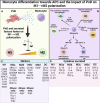Perinatal derivatives: How to best validate their immunomodulatory functions
- PMID: 36185431
- PMCID: PMC9518643
- DOI: 10.3389/fbioe.2022.981061
Perinatal derivatives: How to best validate their immunomodulatory functions
Abstract
Perinatal tissues, mainly the placenta and umbilical cord, contain a variety of different somatic stem and progenitor cell types, including those of the hematopoietic system, multipotent mesenchymal stromal cells (MSCs), epithelial cells and amnion epithelial cells. Several of these perinatal derivatives (PnDs), as well as their secreted products, have been reported to exert immunomodulatory therapeutic and regenerative functions in a variety of pre-clinical disease models. Following experience with MSCs and their extracellular vesicle (EV) products, successful clinical translation of PnDs will require robust functional assays that are predictive for the relevant therapeutic potency. Using the examples of T cell and monocyte/macrophage assays, we here discuss several assay relevant parameters for assessing the immunomodulatory activities of PnDs. Furthermore, we highlight the need to correlate the in vitro assay results with preclinical or clinical outcomes in order to ensure valid predictions about the in vivo potency of therapeutic PnD cells/products in individual disease settings.
Keywords: exosomes; extracellular vesicles; functional assays; immunomodulation; mechanisms of action; mesenchymal stromal cells; microvesicles; perinatal derivatives.
Copyright © 2022 Papait, Silini, Gazouli, Malvicini, Muraca, O’Driscoll, Pacienza, Toh, Yannarelli, Ponsaerts, Parolini, Eissner, Pozzobon, Lim and Giebel.
Conflict of interest statement
The authors declare that the research was conducted in the absence of any commercial or financial relationships that could be construed as a potential conflict of interest.
Figures


References
Publication types
LinkOut - more resources
Full Text Sources

